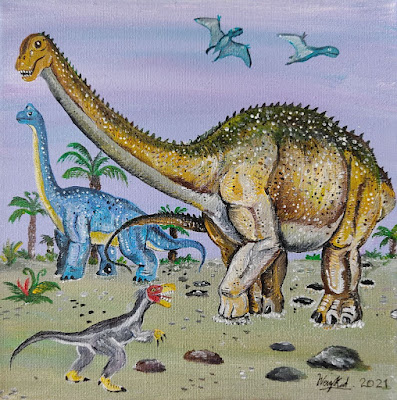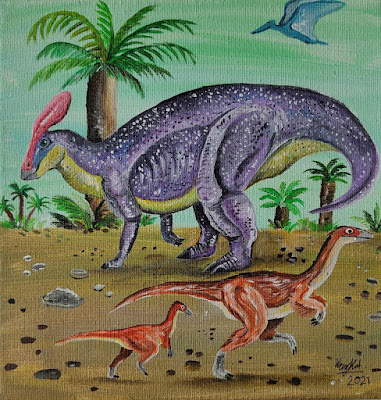Collection: Jurassic Jam-Pack II
JURASSIC JAM-PACK II
Dinosaurs throughout the Mesozoic era come in various shapes and sizes, from small theropods the size of turkeys to large herbivores bigger than a school bus. Dinosaurs evolved a wide range of forms to fill in various ecological roles which are similar to the natural world today. The assortment of the unique families of dinosaurs made the Dinosauria a very interesting group for scientists and popular culture to tap into.
Jurassic Jam-Pack II, acrylic on canvas, 2021. Set of 9, each piece 8" X 8"
Centrosaurus
Centrosaurus, acrylic on canvas, 2021.
Centrosaurus (name meaning "pointed lizard") is a large ceratopsian (horned dinosaur) that lived in the late Cretaceous of Canada, North America. It is noted for the single large horn on its snout, as well as smaller horns above the eyes and hornlets like hooks on its neck frill, which have openings to keep the weight down. Ceratopsians like Centrosaurus normally travel in large herds.
Ceratosaurus
Ceratosaurus Hunt, acrylic on canvas, 2021.
Ceratosaurus (name meaning "horn lizard") is a carnivorous theropod from the late Jurassic period that can be identified for having horns on its head, which consists of a large horn on the nose and two smaller ones above the eyes, that were probably used for display. It had short arms which are actually quite strong. In the painting, it is seen hunting a Dryosaurus (name meaning "oak lizard"), a herbivorous ornithopod that runs on two powerful hind legs. The long-necked herbivore in the background is Apatosaurus.
Cryolophosaurus
Cryolophosaurus in Habitat, acrylic on canvas, 2021.
In the early Jurassic period, Antarctica was a completely different place - it was covered in lush, swampy rainforests that had adapted to months without sunlight, and was home to a diversity of unique dinosaur species. One of the most well-known Antarctic dinosaurs is Cryolophosaurus (name meaning "frozen crest lizard"), known for the peculiar-looking crest that spanned the top of its head from side to side, which may have been used as display or species recognition. This meat-eating theropod preyed on herbivorous dinosaurs such as Glacialisaurus (name meaning "glacier lizard"), a primitive member of the long-necked sauropod group.
Irritator
Irritator, acrylic on canvas, 2021.
Irritator (named for the sheer irritation from the scientists who found the original skull that had been heavily damaged and altered by the actual finder) is a member of the spinosaurid group in the theropod family that lived in Brazil during the early Cretaceous period. It fed on mostly fish, and may sometimes have eaten pterosaurs. It shared its habitat with pterosaurs such as Tropeognathus (top) and land-dwelling crocodilians like Araripesuchus (bottom right).
Sauropelta
Sauropelta, acrylic on canvas, 2021.
Sauropelta (name meaning "lizard shield") is one of the best-known members of the armored nodosaurid family, and also one of the largest, its long tail accounted for much of its length. It possessed an array of four pairs of long spines that stick out from the sides of its neck and shoulders. Living in where is now North America in the middle Cretaceous, it lived in the same area and at the same time as sickle-clawed carnivores like Deinonychus (bottom, name meaning "terrible claw") and large predatory theropods such as Acrocanthosaurus (top left, name meaning "tall spine lizard"). With a suite of predators in its area, the pebbly armor plates and sharp spines of Sauropelta served as protection from their attacks.
Psittacosaurus and Sinosauropteryx
Psittacosaurus and Sinosauropteryx, acrylic on canvas, 2021.
Before the 2000s, scientists have not discovered evidence of skin color on dinosaurs, thus the colors on most reconstructions and paintings of dinosaurs were actually imagined. However, recent groundbreaking discoveries of melanosomes (cells containing the pigment melanin which gives skin color) have confirmed the colors of a few dinosaurs. In 2016, the dinosaur Psittacosaurus (name meaning "parrot lizard" for its parrot-like beak) is discovered to have a brown countershaded color, which may have enabled it to camouflage itself on the forest floor. Psittacosaurus lived in the early Cretaceous of China, Mongolia, Russia and Southeast Asia and is a member of a dinosaur family that would evolve into the horned dinosaurs like Triceratops. The small theropod Sinosauropteryx (bottom, name meaning "Chinese lizard wing") was the first dinosaur to have its life coloration described by scientists based on physical evidence, namely its feathers. Melanosomes on the feathers reveal that the small carnivore had light and dark bands on its tail feathers and a raccoon-like bandit mask on its head. The pterosaur flying above is Boreopterus (name meaning "northern wing"), a crested pterosaur from China. In the distance, a Wuerhosaurus, one of the last stegosaurids, can be seen.
Supersaurus
Supersaurus, acrylic on canvas, 2021.
Supersaurus (name meaning "super lizard") is a large sauropod from the late Jurassic of North America. It is estimated to have measured 30 meters long, and had a longer neck than the more well-known Diplodocus. It was among the largest dinosaurs known from well-studied fossils. The sauropod behind the Supersaurus in the painting is Brachiosaurus. At the bottom left of the painting is Ornitholestes (name meaning "bird robber"), a fox-sized theropod that ate small reptiles and mammals. The small pterosaurs flying above are Mesadactylus (name meaning "flat hill finger").
Tlatolophus
Tlatolophus, acrylic on canvas, 2021.
Tlatolophus (name meaning "word crest") is a large hadrosaur that is related to the famous Parasaurolophus but with a shorter crest. Discovered most recently in 2021, this herbivore lived in Mexico during the late Cretaceous period, and is said to have communicated using low-frequency sounds produced from the hollow cavities inside its crest. The theropods at the bottom of the painting are an adult and juvenile Tototlmimus (name meaning "bird mimic", in which "tototl" means "bird" in Nahuatl). It had a typical build for a bird-mimic or "ostrich" dinosaur (ornithomimosaur), having a bird-like head and long legs for running long distances at high speeds.
Yutyrannus
Feathered Tyrant, acrylic on canvas, 2021.
Yutyrannus (name meaning "feathered tyrant", in which "yǔ (羽)" means "feather" in Chinese) is a primitive member of the tyrannosauroid family that lived in the Early Cretaceous of China. Yutyrannus is currently the largest-known dinosaur that is known from fossils that display direct evidence of feathers. This large carnivorous theropod may have hunted long-necked sauropods. The small theropod resting at the bottom left is Mei long (寐龍, "sleeping dragon"), a duck-sized troodontid that is related to the raptors. It ate small lizards and insects on the forest floor. The first fossils of Mei were discovered in a resting position, indicating it had been buried during a volcanic eruption while it is sleeping, hence the name. The bird in the picture is Confuciusornis, known for being the earliest known bird to have a toothless beak.













Comments
Post a Comment